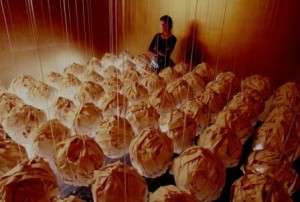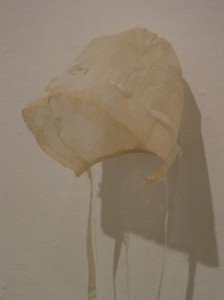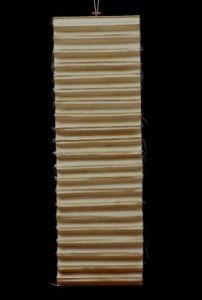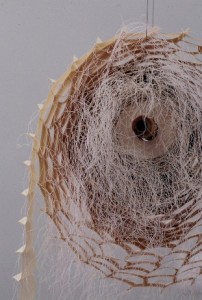Artist Stephanie Speight
“The act of creating is critical to my personal well being. It is the avenue through which I approach everything. I am simply not happy if not engaged in the act of manipulating materials toward some new end.”
Stephanie Speight credits her upbringing on an Oregon farm for her love of nature, gardening, food preparation and the need to be resourceful. She has brought this history into her work as a chef and an artist who creates new life out of old things.
Stephanie attended Oregon State University, majoring in foods and nutrition, but gravitated to art classes whenever her schedule allowed. She worked in clerical positions and in commercial kitchens, putting her interest in art on hold while raising a family. In 1994, she returned to school and earned her BFA at Marylhurst College. She currently works as a pastry chef at New Season’s market and has an upcoming art show scheduled for August at the Nine Gallery in Portland, Oregon.
Stephanie, when did you know you wanted to be an artist? What drew you to create?
I never thought about using the word “artist” to describe myself. That word I reserved for Ann Hamilton, Eva Hesse, Richard Tuttle, Agnes Martin… some of my idols. What I did know was that I loved to mess around and when I messed around two things happened. I completely lost myself, and something appeared that I could not have possibly thought up had I not been “lost”. Being in that “empty space” was what I wanted more of, and my formula for getting there was found in the act of manipulating materials. I needed to learn more about materials.
Raising children while hanging out in the “empty space” doesn’t always work well. Once the kids were pretty much on their way, I got the green light and off I went to Marylhurst to get my degree in “messing around”. Even to this day, that word “artist” seems lofty.
I pretty consistently gravitate toward used or found materials. There is something I find deeply satisfying in rescuing, reusing, repurposing, “stuff” that already exists, as opposed to adding new “stuff” to a world that’s already so full of “stuff”.
What was the most challenging project you ever did and why?
That would be a show at Archer Gallery, the title of which was, Sunny Valley Oregon Ecole de Couture, an exhibition of garments sewn using tissue paper. I had been mindlessly sewing away using old patterns from the 50’s in conjunction with an old moth eaten roll of tissue paper without thought of why or where this might lead. I was learning to sew in a most challenging way and when I finished the first dress, I was so carried off by its fragile nature and the way in which light played with the paper, I promptly started cutting out another. With the completion of each, I’d let down a bar, via a crude pulley arrangement I’d rigged up in our living room, and hang the garment there. Over a period of a year, the collection of 1950’s style garments inhabited the upper reaches of the living room like a gathering of ghosts.
The curator for the Archer Gallery at Clark College, Margery Hirsch (now retired), was very interested in what I was doing and wanted to give me a show. Carried off by her enthusiasm, I agreed without really thinking it through. The gallery at Clark was a large windowless (basement) space which kindled an interest in illuminating the garments from within. As time marched on, I was confronted by so many technicalities: there were expenses, and the stipend from Clark wasn’t huge. How on earth was I going to pull it off? That particular time was challenging as I had Mom on my mind and getting her into a safer situation. My brain was split down the middle. I tried several times to get out of doing this show as I was feeling overwhelmed, but Margery was just so supportive, encouraging and helpful that I trudged on. It took me two years before the show came together with the help of friends, the Artist Trust and the college, and it was well received.
You cared for your mother for several years as her health declined and then lost her this past spring. How was the creation or experience of art healing for you during this time?
I had a show at the Nine Gallery in Portland which dealt with old trim work from houses being demolished. That show was about repurposing old painted wood. People were surprised. Where was the lovely paper? The impetus for that work came from a need to spend time in the garage instead of in my little studio space (a 10 x 10 former bedroom) in the house. Mom took to whistling about 6 months after we moved her in. She whistled every waking minute, unless she was eating. She couldn’t help herself. It had to do with the progression of her dementia, and I tried everything I could think of, or that was recommended to stop it – to no avail. I found my escape in head phones & power tools: table saw, belt sander, chop saw, etc.
The best single example of “art as healing” as it pertains to my creative journey circles back to Mom and her whistling. As sweet as whistling can be, to have it nonstop in the center of your house is equivalent to Chinese water torture. It drove me stark raving crazy! I cannot adequately put into words the cumulative effect of 6 years of nonstop whistling. I had tried so many ways to deal with it, and finally hit upon a plan to turn a negative into a positive. Borrowing a video camera from a friend and video artist, Horia, I set it up in the house. Whenever Mom was up, I’d flip it on, capturing action and the whistling. This I continued for several weeks. I caught her in all sorts of situations: reading the paper, visiting, watching TV, sorting buttons, knitting, etc. – all the while whistling. The camera was returned to Horia’s studio and the plan was that he would assist me in the editing process, and perhaps I’d come up with something meaningful in the end. Six months passed and one day Horia called saying he’d been watching some of the footage and that I should come down to his studio. I wasn’t anxious to comply, as I was still living with it day to day. Why would I want to drive across town to listen to more? But I did. It was the most amazing experience! I was observing the phenomenon from a whole new perspective and it was hauntingly beautiful. This “thing” that had nearly driven me off a cliff, was now so utterly profound.
After the experience in Horia’s studio I was less tortured by Mom’s obsession. Over the next 2 years, her repertoire of songs shrunk, and there would be times of silence. In the last year Mom stopped whistling. The silence seemed huge. She was such a sweet sweet thing and I miss her.
What places, artworks or artists do you turn to for inspiration?
I look for inspiration right under my nose, or mostly in stuff I drag home. I have an affinity for artists working conceptually or classed as minimalists (Agnes Martin, Donald Judd, Ann Truitt). Installation art is also at the top of my list (Ann Hamilton). I have a few close artist friends that I spend time with – they keep needling me.
As an artist, what is ahead for you in 2013?
The act of creating is critical to my personal well being. It is the avenue through which I approach everything. I am simply not happy if not engaged in the act of manipulating materials toward some new end.
I have a show scheduled for 2013 on which I’ve not begun. Garments are still of interest, and instead of paper I have two old sails that my uncle Pat gave me about a year ago (he was a sailor). I have sewn one shirt using a chunk of one sail, and showed that piece in a group show last September. The desire to create another collection of garments is strong. We’ll see if that happens . . .
Stephanie, thank you for sharing your story with Healing Hamlet. We look forward to seeing more of your work at Portland’s Nine Gallery this coming August!
- Posted in: Healing ♦ Interviews ♦ Archer Gallery ♦ Nine Gallery ♦ Stephanie Speight





